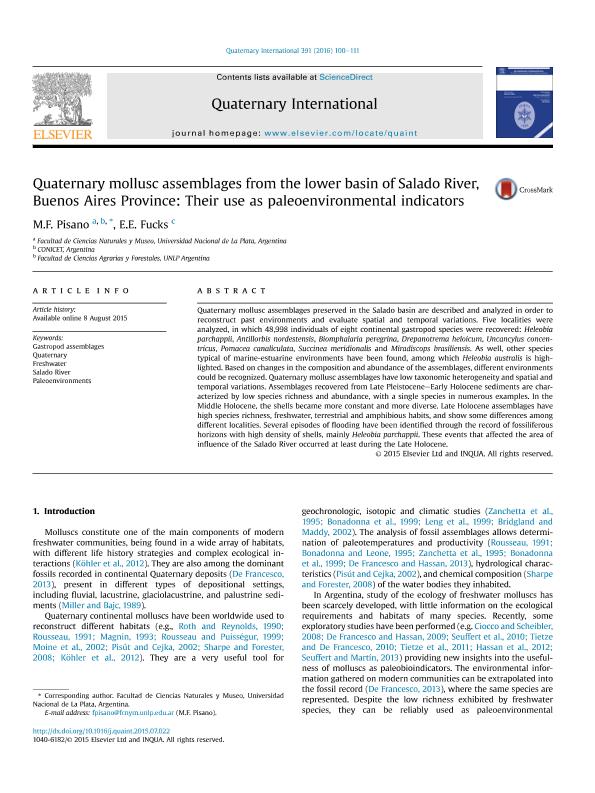Mostrar el registro sencillo del ítem
dc.contributor.author
Pisano, Maria Florencia

dc.contributor.author
Fucks, Enrique Eduardo

dc.date.available
2018-07-31T18:38:59Z
dc.date.issued
2016-01
dc.identifier.citation
Pisano, Maria Florencia; Fucks, Enrique Eduardo; Quaternary mollusc assemblages from the lower basin of Salado River, Buenos Aires Province: Their use as paleoenvironmental indicators; Pergamon-Elsevier Science Ltd; Quaternary International; 391; 1-2016; 100-111
dc.identifier.issn
1040-6182
dc.identifier.uri
http://hdl.handle.net/11336/53624
dc.description.abstract
Quaternary mollusc assemblages preserved in the Salado basin are described and analyzed in order to reconstruct past environments and evaluate spatial and temporal variations. Five localities were analyzed, in which 48,998 individuals of eight continental gastropod species were recovered: Heleobia parchappii, Antillorbis nordestensis, Biomphalaria peregrina, Drepanotrema heloicum, Uncancylus concentricus, Pomacea canaliculata, Succinea meridionalis and Miradiscops brasiliensis. As well, other species typical of marine-estuarine environments have been found, among which Heleobia australis is highlighted. Based on changes in the composition and abundance of the assemblages, different environments could be recognized. Quaternary mollusc assemblages have low taxonomic heterogeneity and spatial and temporal variations. Assemblages recovered from Late Pleistocene-Early Holocene sediments are characterized by low species richness and abundance, with a single species in numerous examples. In the Middle Holocene, the shells became more constant and more diverse. Late Holocene assemblages have high species richness, freshwater, terrestrial and amphibious habits, and show some differences among different localities. Several episodes of flooding have been identified through the record of fossiliferous horizons with high density of shells, mainly Heleobia parchappii. These events that affected the area of influence of the Salado River occurred at least during the Late Holocene.
dc.format
application/pdf
dc.language.iso
eng
dc.publisher
Pergamon-Elsevier Science Ltd

dc.rights
info:eu-repo/semantics/openAccess
dc.rights.uri
https://creativecommons.org/licenses/by-nc-nd/2.5/ar/
dc.subject
Freshwater
dc.subject
Gastropod Assemblages
dc.subject
Paleoenvironments
dc.subject
Quaternary
dc.subject
Salado River
dc.subject.classification
Paleontología

dc.subject.classification
Ciencias de la Tierra y relacionadas con el Medio Ambiente

dc.subject.classification
CIENCIAS NATURALES Y EXACTAS

dc.title
Quaternary mollusc assemblages from the lower basin of Salado River, Buenos Aires Province: Their use as paleoenvironmental indicators
dc.type
info:eu-repo/semantics/article
dc.type
info:ar-repo/semantics/artículo
dc.type
info:eu-repo/semantics/publishedVersion
dc.date.updated
2018-07-31T17:20:44Z
dc.journal.volume
391
dc.journal.pagination
100-111
dc.journal.pais
Estados Unidos

dc.description.fil
Fil: Pisano, Maria Florencia. Universidad Nacional de La Plata. Facultad de Ciencias Naturales y Museo; Argentina. Consejo Nacional de Investigaciones Científicas y Técnicas; Argentina
dc.description.fil
Fil: Fucks, Enrique Eduardo. Universidad Nacional de La Plata. Facultad de Ciencias Agrarias y Forestales; Argentina
dc.journal.title
Quaternary International

dc.relation.alternativeid
info:eu-repo/semantics/altIdentifier/doi/http://dx.doi.org/10.1016/j.quaint.2015.07.022
dc.relation.alternativeid
info:eu-repo/semantics/altIdentifier/url/https://www.sciencedirect.com/science/article/pii/S1040618215006989
Archivos asociados
